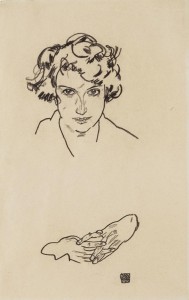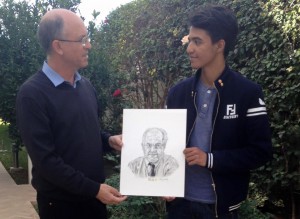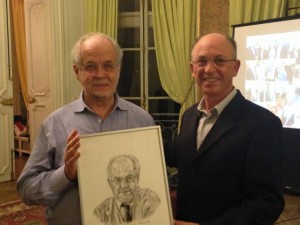Pour ceux qui s’interrogent sur les objectifs de Connect Institute. La réponse est en partie dans cette connexion entre un jeune artiste gadiri qui débute et une grande personnalité internationale qui se retire. Le premier c’est Said, dessinateur, inscrit au programme edART. Le second c’est Michael Z. Cutajar, ponte et parrain des négociations globales sur le climat. Le premier, fier de son œuvre, a dessiné le portrait du second qui l’a beaucoup apprécié.
Voici quelques commentaires d’Alexandra qui a travaillé avec Michael et qui a des connaissances en dessin:
« Here are, as promised, a few words on Said’s drawing. I thought it was very well executed, and it is especially impressive that it was drawn in three hours ! As I mentioned yesterday, he did a really good job of creating contrast in the drawing, as this is what gives a drawing depth (which is an essential illusion since paper is flat!). I find it takes practice to translate from colored reality to a black and white drawing the areas that are darkest.
Here my impression is also that he perhaps accentuated even further some parts such as the tie (perhaps the tie was not so dark in the picture). This I find gives a good counterpoint to the eyes (also dark) and the crease under the right arm. Another aspect I find excellent in this drawing is the detail.. he really used many different types of shading methods to very realistically depict the hair, the wrinkles on Michael’s forehead, and the pleats in his shirt.
I showed it to my colleague who draws a lot and she also found it was masterly executed, and said she thought she herself might not be able to draw such a realistic-looking drawing. And finally, I also mentioned to you yesterday that drawing faces is difficult, as it is very easy to identify if any proportions are wrong (as we are so familiar with looking at peoples’ faces).
Now for a few other ‘constructive’ critiques. As I mentioned yesterday, it is much easier to draw something from a picture (which is already flat) than from real life. This is why artists and professors typically always exhort students to draw from real life. Of course, here it was not possible ! But this is just to say that if so far he has mostly drawn from images, it would be great practice to move to drawing from real life (but perhaps, judging on his level of technical mastery, he already has). Another comment that my colleague who draws, and another colleague who doesn’t draw made was that despite the resemblance with Michael, the expression on his face was not exactly that of Michael’s. I think it might be in particular the mouth that has an expression that is a bit off. But again, this might be due to the fact that he was drawing from an image.
 My colleague who draws also said that perhaps what is more interesting than technical mastery, is precisely being able to bring across someone’s real expression. In light of that, I’d suggest that now that he has technical mastery, he should try to develop his own personal style. Notably to go beyond what is purely faithful to reality to something that integrates his own additional creativity, and really brings across un regard. I’m attaching an example of a drawing from Egon Schiele, which although is only composed of a few lines, really I feel creates a penetrating and powerful gaze. I’m sure that by looking at a lot of different great artist’s portrait paintings and drawing he can find some inspiration. I’d personally look at 20th century artists who have been very creative.
My colleague who draws also said that perhaps what is more interesting than technical mastery, is precisely being able to bring across someone’s real expression. In light of that, I’d suggest that now that he has technical mastery, he should try to develop his own personal style. Notably to go beyond what is purely faithful to reality to something that integrates his own additional creativity, and really brings across un regard. I’m attaching an example of a drawing from Egon Schiele, which although is only composed of a few lines, really I feel creates a penetrating and powerful gaze. I’m sure that by looking at a lot of different great artist’s portrait paintings and drawing he can find some inspiration. I’d personally look at 20th century artists who have been very creative.
In any case, I definitely think he should continue to pursue drawing !
Best of luck to him »
Alexandra












